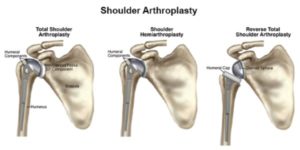
By: Kara Everett, PT, DPT, CSCS, CKTP
LSVT BIG Certified
Operations Director, Hartfield Location
Due to the aging population, as therapists, we are seeing an uptick in elective shoulder surgeries. The incidence of shoulder arthroplasty per 100,000 members increased from 6.1 (95% confidence interval [95% CI] 5.5-6.7) in 2005 to 13.4 (95% CI 12.5-14.2) in 2013.
Two of the most common shoulder surgeries we see at Carousel are rotator cuff repairs and shoulder arthroplasty (shoulder replacement surgery). Rotator cuff repairs can vary greatly based on the extent of damage to the shoulder and thus can affect recovery times. With shoulder replacements (regular and reverse shoulder replacements) all or part of the shoulder is replaced.


In both types of shoulder procedures, surgery is only performed when other conservative treatments have failed to provide pain relief or if you have significant difficulty in performing day-to-day activities as a result of shoulder pain. These surgeries can help reduce pain and improve the use of your shoulder but the recovery time from these surgeries are significant and requires some work to get the full benefit of surgery.
If you or someone you know needs shoulder surgery, knowing what to expect can help you have a better outcome. Here are four things to know about shoulder surgery:
1. Managing pain after surgery.
You can expect some pain after shoulder surgery. As you heal your pain will reduce drastically and most have trace to no pain following recovery.
Work with our physical therapists to understand positions and exercises that reduce pain and help you heal. Work with your surgeon and pharmacist to understand the dosing of pain medications after surgery. It is important to have a plan to wean off opioid medications in a timely manner.
Research shows that taking prescribed opioids before surgery leads to worse pain management after surgery. Consider weaning off these medicines prior to surgery with the supervision of your health care team. This can help with your pain management after surgery.
2. An initial need for help and assistance.
You can expect to be in a sling for weeks. You will not be able to use your arm for anything except prescribed exercises. Our therapists will teach you specific exercises to promote healing.
Consider having ready-to-eat meals that are easy to prepare. You may want to set things up at home that you need regularly at an easy-to-reach level. Button-up shirts are the easiest to wear while you cannot lift your arm.
Let your friends or family know that you are having major surgery, so they can support you while you recover.
3. Difficulty sleeping.
Initially, sleep may be difficult after surgery but will improve with good habits. Good sleep habits, also known as sleep hygiene include:
- Avoiding large meals and caffeine before bedtime.
- Limiting or avoiding alcohol.
- Avoiding nicotine.
- Removing electronic devices from the bedroom.
- Having a regular set bedtime.
Finding a well-supported position will also be important. Our therapists will educate you on sleeping positions that are safe for your shoulder and minimize pain and maximize comfort.
4. Improved mobility and function.
Physical therapy is a critical part of recovery after shoulder surgery.
However, before your surgery, our physical therapists can help you improve your shoulder mobility and strength for better outcomes after surgery. Prehab is the use of exercises to improve strength, range of motion, flexibility, and/or balance. Research has shown that an 8-week program of a strength and balance training program prior to your shoulder surgery can reduce pain and improve overall mobility and outcomes following a joint replacement. The same principle can be applied prior to any surgery including knee, hip, back, and neck surgery.
After surgery, a hospital physical therapist will educate you about what precautions to take when you go home and what movements to avoid during the initial healing phase. They also will teach you how to manage your affected arm, how to put on and remove your sling, get dressed, and get in and out of bed.
After discharge, continuing physical therapy is essential to ensure your safe recovery. Our physical therapists will work with you to progress your exercises at the right times in the healing process based on your doctor’s post-surgical protocol. We will help you get back your range of motion, improve your strength and function, and eventually help you get back to your everyday activities, job, or sport.
Our care revolves around you so be sure to let us know your goals so we can focus on returning you to the important things in life.

